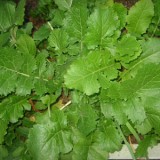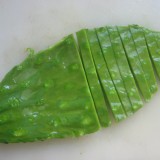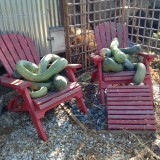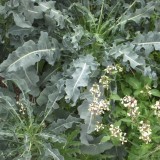 Lyn, a reader in Canada with way too many hot peppers on hand, asked us what we thought we should do with them. We have the same problem here this year, an overabundance of very large, hot Italian Long Peppers. Thumbing through some recipe books we realized that we had all the ingredients to make Harissa, a spicy Moroccan condiment. The recipe is simple and quick. We cut open five of our hot peppers, discarded the seeds, and combined them in a food processor with:
Lyn, a reader in Canada with way too many hot peppers on hand, asked us what we thought we should do with them. We have the same problem here this year, an overabundance of very large, hot Italian Long Peppers. Thumbing through some recipe books we realized that we had all the ingredients to make Harissa, a spicy Moroccan condiment. The recipe is simple and quick. We cut open five of our hot peppers, discarded the seeds, and combined them in a food processor with:
1 tsp salt
1 tsp cumin
1 tsp caraway seeds
2 tsp coriander seeds
1 tsp fresh mint
3 garlic cloves
Turn on the food processor and add enough olive oil to form a paste. That’s it. Harissa will last several weeks in the fridge or you can freeze it. You could also can it, but you’ll need a pressure canner as this is a low-acid food (even though it’s fiery).
And speaking of fiery, though we should know better (having once accidentally inhaled hot pepper seeds), we disregarded warnings about wearing rubber gloves when slicing the peppers. At the risk of providing too much information, a post Harissa making trip to the bathroom led to, shall we say, burning sensations for Señor Homegrown Evolution!
Burning sensations aside, Harissa is a very tasty and spicy addition to almost any meal, not just Moroccan dishes. We still have peppers to deal with, so our next project will be to experiment with pickling them. Readers–what’s your favorite way to deal with hot peppers?





Great idea! Thanks!
I also had an unfortunate hot pepper experience. This past week I made a monster batch of salsa and must have rested my hand in the juice/seeds from the peppers because my hand burned for the rest of the night!
Oh Dear-
Sorry about your trial-by-fire!
As mt professor in college used to say in her lab safety lesson:
“You can always tell a chemist because he washes his hands BEFORE going to the bathroom!”
(Lots of Dawn washing liquid, hot water and a scrub brush work to get it off..eventually.)
As for the peppers- I’d try freezing them for future flavoring use the same way I do cilantro:
Wash, dice, then puree with a little lemon juice and olive oil (garlic optional). Leave rough or strain us9ing a rubber spatula to push the puree through a sieve. Freeze flat in a double plastic bag with all the air pushed out, then break off bits to thaw and use in sauces, etc. for 6 months to a year. EXCELLENT when mixed with spices and mayo for a sandwich!!
I’m in the same boat and looking for a good canning recipe for pickled carrots with jalapenos. I love spicy carrots, but all the recipes I have found online so far look rather sketchy, at least from the canning angle. Spicy carrots = good, botulism = bad.
Hey There-
I’m at slow food nation and just was talking to a chef that what he does with the extra pepper is put them whole in the dehydrator and then pulverizes them with a mortar and pestle to make a powder which he uses on everything. In fact, he does this same thing with all vegetables making veggie powders. Then he puts those powders in butter, soups, sauces, mashies (that’s my idea. I am very excited about the possibility of this! Cheers!
Low acid canning = use the pressure canning method…
Hi mates,
writing from Italy…
So, you probably already know this recipe but i tell you, take your pepers, a clean glass bottle and a liter of olive oil (don’t know the english tranlsation but it has to be “extra vergine” that means the best kind of olive oil). Put the peppers in the bottle (don’t break or crush them) and the fill the bottle with the oil. Leave the bottle in a fresh dark place for at least one month and you’ll have a wonderful iper hot oil you can put almost everywhere (pizza, pasta, bruschetta….) You can do it also with dryied peppers.
Ciao
Stringing those peppers on thread and hanging them above the kitchen window adds great color to the kitchen come winter, plus you have a great amount of dried peppers with in hands reach of the cutting board.
Love the blog y’all, keep it up!
For those who haven’t hooked up to solar or wind…is it time to learn to live without electric kitchen appliances, again?
The idea of using a food processors, electric canopeners, blenders, etc…doesn’t bother me if folks aren’t using fossil fuel to power it.
But those readers who are still pigging out on fossil fuels, PLEASE learn how to follow these recipes the old fashioned way. Use potato mashers, forks, or ricers.
If you’d like to make harissa the traditional way you’ll use a mortar and pestle.
As far as fossil fuels go, personally, we can’t afford solar panels right now and I’d rather see folks cook at home using a food processor than buy processed supermarket foods. While I’m not a fan of silly kitchen gadgets, I’m a strong proponent of the few that we have: a heavy duty mixer (for kneading bread) and the aforementioned food processor (for making sauces, pesto, soup, etc.).
We all pick our battles I suppose. Of course, you could also make the argument that the harissa would taste better if it were made in a mortar and pestle . . .
Rita-
I understand your concern, and it’s valid. And after a long time of living as a poor grad student in quarters that would only house a few bowls, a whisk, mortar and pestle, etc. I grew very good at using them.
However, if you live in an apartment and can’t control your environment enough to use solar power, BUT you have enough ingenuity to save travel and fossil fuels by growing your own bumper crop o’ veggies, some allowances have to be made. Some electrical appliances make the preparation not only easier, but SAFER and CLEANER, so compromise and some fuel savings are better than none. Trying to solar dry in my sun-limited sans-balcony apartment would merely mold my entire crop. We can’t all be pure.
But if you have the facilities and would like to host a “Green preserving party” next year, hey, I’ll bring the hummus! 🙂
i’m glad that people are talking about the environmental implications of how we homestead. when it gets down to it, these are all useful questions, because we far too often assume that a practice is a green one simply because it seems traditional/old-fashioned. its important to search for efficient methods & ask ourselves if our task merits the fossil fuel energy that we are putting towards it!
also, i wanted to share an incredible PICKLED PEPPER RELISH RECIPE that i recently adapted from the New Mexico State Fair winning recipe from this year. I only used 3-4 sweet peppers in this recipe & the relish came out rather hot. Adjust the sweet-hot ratio depending on your taste buds & your crop!
5 cups diced peppers
1 T salt
1 cup cider vinegar
1 cup water
1 cup sugar
mix peppers & salt. cover with boiling water & let stand for 10 minutes. strain. add vinegar, water & sugar. bring to a boil & simmer for 10 minutes. jar!
this relish is incredible on sandwiches, or tossed with hardboiled eggs. enjoy!
Hello,
I’m an old hand at canning peppers, and my favorite recipe is adapted from my grandmother’s dilly beans recipe:
Brine:
5 c. white vinegar
5 c. water
1/2 c. kosher or canning salt
Bring to boil and pour very hot over jars packed with:
1/2 tsp mustard seed
1/2 tsp dill seed
1 (or more) clove garlic
sliced hot peppers, packed tightly
Process in boiling water bath, 5 minutes for pints, 10 minutes for quarts.
If my peppers are too hot for general consumption, I add carrot sticks, leek slices, onions, green beans, or other less spicy fillers to the jars.
Another favorite recipe I’ve developed is my mixed pepper hot sauce:
2 c. stemmed whole habanera or other hot pepper
2 c. Anaheims, Hungarian wax, ancho, or other milder pepper
1 med onion
1 med tomato
3 cloves garlic
Combine produce in food processor and dice finely. Heat to boiling and simmer for 45 minutes. Put sauce through food mill with medium sized sieve. Add lime juice, sugar, salt, and white vinegar to taste (small quantities. Reheat to boil and simmer for 15 minutes. Jars will keep for more than a year when refrigerated.
Variations: bright red or bright green sauce can be made by using only that color of produce. Add bell peppers if a milder sauce is desired.
mel, thank you for the memories – sounds like one of my grandma’s pepper mixes. i sure do miss her, but i don’t much miss her tongue-scorching chiles!
Last year (2012)was unusualy hot and dry in Ohio, The nameless peppers I planted peppers thrived, ranged in color from hi-liter yellow to fresh lava orange and were uniformly blazing hot. After making a lifetime supply of various condiments including the harissa (yum!) I made garden spray by warming a few cups of slices in vegetable oil in the crock pot, which ended up cooking on the deck due to the irritating fumes. I stored it in an old jar and used a few spoons full to a quart spray bottle filled with water and a squirt of dish soap to spray squash, pea and bean vines early on, then tomatoes a bit later in the season. It really cut down on vine and leaf eating caterpillars and the like, plus kept the squirrels, coons and deer largely in check.